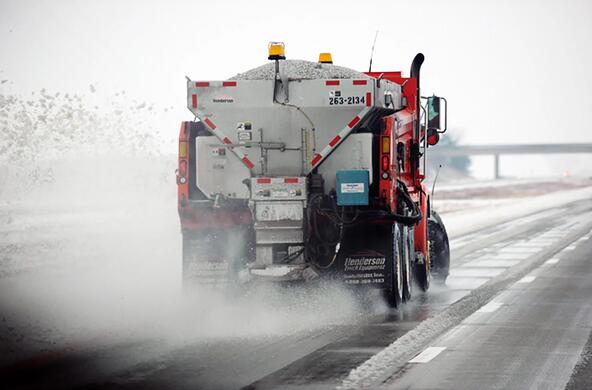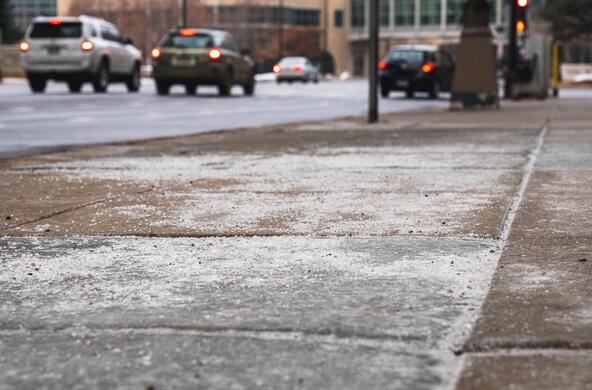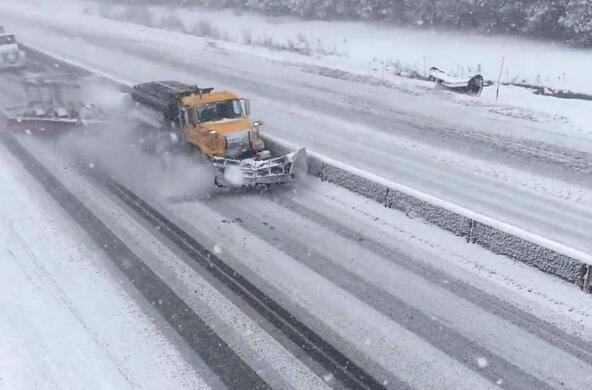Storm Jonas made it clear how important road salt is for keeping the streets and sidewalks of New York City clear of snow and ice. The Department of Sanitation had more than 300,000 tons of it on hand to deal with Jonas, more than the weight of three aircraft carriers.
But many scientists say all that road salt poses a serious threat to the environment and infrastructure. One New Yorker won't stop pestering her City Councilwoman until the City replaces salt with a less corrosive substitute. But she is not getting a lot of traction.
Her main complaint is on behalf of the city's dogs. "Rock salt is toxic," said Marjorie Jacobs, a retired high school English and history teacher who lives in Manhattan. "It erodes my dogs' paws and makes cracks in the pavement." Four winters ago, Jacobs was walking her two mutts, Benjamin and Theodore, through her neighborhood on the Upper West Side when she noticed the bottom of their paws were chapped, and stayed chapped even after she applied Vaseline and paw wax.
"I washed the paws with warm water, I tried boots but the dogs wouldn't keep them on," said Jacobs. "I spoke to a lot of animal owners in Riverside park and they complained about the same thing: their dogs' paws were hurting." Salt, it seems, dries out a dog's paws just like it dries out a snail's skin. "It creates cracks in the paws and can lead to infections," said Dr. Pamela Edwards, who works at New York Veterinary Hospital on the Upper East Side.
And dogs, it turns out, are not the only creatures that road salt can hurt. For four years, Jacobs has been asking City Councilwoman Helen Rosenthal to do something about the road salt, which the U.S. Geological Survey has called "an increasing threat to aquatic ecosystems." According to Virginia Tech water treatment expert Marc Edwards in a recent article for The Guardian, road salt in the Flint River was a major factor behind the corrosion of plumbing infrastructure, which released lead and into the water system once the city of Flint switched to the river for its water source.
"In Flint the corrosive water affected the lead pipes," said Sujay Kaushal, a geology professor at the University of Maryland, who has studied the effects of road salt in Baltimore and upstate New York. "That's a real wake-up call." Salt, he adds, mobilizes contaminants and has harmful effects on biological organisms.
Road salt—aka sodium chloride—freezes at a lower temperature than water. When salt is applied to water, the water won't freeze at temperatures above -6° Fahrenheit. Salt can also help existing ice melt faster. However, as the ice melts, the salt atoms dissolve into separate sodium and chloride ions. Chloride ions are very corrosive, and that is what can affect drinking water resources.
For residents of Flint, that corrosion meant anemia, memory loss, and brain damage in young children from the lead in the pipes. Last summer, high sodium chloride levels from road salt in the Potomac River, combined with decaying plumbing infrastructure, sent a wave of brown drinking water through the faucets of wealthy Maryland suburbs surrounding Washington D.C. New York City is also vulnerable to potential drinking water problems. Many of the 6,000 miles of pipes, shafts, and aqueducts linking the city to the Catskill-Delaware watershed are more than 70 years old and wearing down. The combination of decaying infrastructure and corrosive road salt from development in the Catskills could be the perfect mix for Flint-like disaster.
But so far the New York City Council hasn't thought the issue worth its salt. At a City Council meeting last September, Rosenthal proposed Intro 913, a bill that would require businesses and the Department of Sanitation to use a substitute for salt for de-icing roads. But that hasn't led to change. "I think it's something that people just take as a status quo," said Stephanie Buhle, Helen Rosenthal's director of communications. "'Of course you use that [road salt] for snow.'"
"We would love to have a hearing on it, but no hearing has been scheduled," said Buhle. "The chair of the Sanitation committee decides on the meeting...I don't know what other bills are on their agenda."
The office of Councilman Antonio Reynoso—the chair of the Sanitation Committee—was reluctant to speak at length about the bill. So was the office of the Public Advocate, Laetitia James, who co-sponsored the bill. "The city should explore using alternatives to road salt like sand or sawdust that can still be easily washed away by the Department of Sanitation," wrote James in a statement responding to this reporter's questions. However, there doesn't seem to be much momentum for exploring those alternatives.
And that seems to be blowing up in New Yorker's faces—Literally. NBC News reported that 400 manhole covers caught fire or exploded in the six days following the end of Storm Jonas. The reason: road salt. Melting snow carries road salt into the underground tunnels lined with electric wires, many of which are already torn and frayed by the nibbling of rats and the rumble of subway trains and street traffic. Salt not only helps corrode those wire, it also conducts electricity through the tears and burns the wire's insulation. The burning insulation releases gas and smoke, and if enough gases build up while the wire burns...then a 300-pound manhole cover can fly over five feet through the air.
"It's not unusual for us," said Sidney Alvarez, a spokesman for Con Edison, New York City's electrical provider, about the manhole cover explosions. "We work on it every single year."
In 2005, ConEd began replacing its manhole covers with vented ones, which allow gases to escape before an explosion happens. Alvarez wrote in an email that 121,025 manhole covers have been replaced and the goal is to replace another 55,000 before 2019. But the explosions are still happening at a rapid rate.
Meanwhile, road salt is not good for our region's fish and aquatic life. As the snow melts and carries salt into streams, it effects the freshwater ecosystem in place there. "Aquatic organisms are used to living in freshwater," said Victoria Kelly, who is a program manager at the Cary Institute for Ecosystem Studies. Since 1986, Kelly has studied the salt concentrations in the streams of Dutchess County, about two hours north of New York City. "When there is more salt water, it changes their [the organisms'] behavior and impacts their ability to reproduce," said Kelly.
Salt absorbs water, and when it's applied to the surface of a frog or salamander it sucks up water from their permeable skin and dehydrates them to death. "Salamanders and frogs and insects might not enter an area that has high salt concentration," said Kelly. "That limits their ability to find food or mates; they have less habitat if part of a stream is too salty."
Birds can mistake salt crystals for seeds, and salt will soak up moisture from plants if it gets into the soil, creating drought conditions. Once salt gets into the soil it can stay there for a very long time.
"Salt doesn't just flush out of the system the year it's put onto the roads," said Kelly. "It can be retained in soil, groundwater, stored in sediment in lakes and ponds." In a 2008 report, Kelly found that concentrations of sodium and chloride in the East Branch of Wappinger Creek (a stream in Dutchess County) were three times higher in 2005 than they were in 1986. Kelly estimated that salt used for deicing roads accounted for 91 percent of the sodium chloride input in the watershed.
Despite the disadvantage of road salt, Kelly is skeptical of most of its alternatives.
"Cheese brine and pickle brine are salty," she said, adding that beet juice is less corrosive, but it must be mixed with salt to be effective. Plus, organic de-icers could have unintended consequences. Kaushal explained how decomposers like algae reproduce rapidly when organic material is dumped into a waterway. The decomposers use up all the oxygen in a waterway and can kill off the rest of the species there. Sand is another widely-used alternative, but too much of it can clog waterways and stop light from reaching life on the streambeds.
"I think we're stuck with salt for now," said Kelly. "Mostly the focus is on becoming more efficient with salt."
Kelly explained that pre-treating roads with a briny salt solution prevents ice from forming a bond with the pavement, which reduces the amount of salt needed overall. And Kaushal thinks the best way to reduce salt pollution would be to set limits on how much is allowed in waterways. The Environmental Protection Agency includes chloride on the list of 15 contaminants that make up its National Secondary Drinking Waters Regulations, but the EPA does not enforce the acceptable levels of these contaminants. Instead "They are established only as guidelines to assist public water systems," according to the EPA website. "Right now we're not recognizing it as a problem that needs to be regulated," Kaushal said about road salt.
Salt is one of countless contaminants drifting through the New York City ecosystem. But little research has been done about it. Scientists at Columbia University's Earth Institute, The New School's Urban Ecology Lab, and New York University's Department of Environmental Studies not only haven't studied the effects of road salt in New York City, but they also said they did not know of anyone else who had.
"We would love it if there was noise made about this," said Buhle, Councilwoman Rosenthal's director of communications. Until then, Marjorie Jacobs will continue her campaign against road salt. "I am persistent," she said. "I will keep making that phone call or stop by the office until the goal is accomplished."








